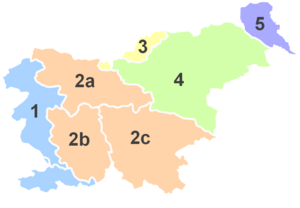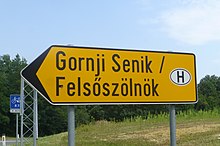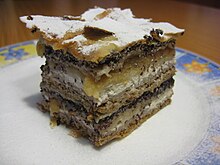Prekmurje
This article has multiple issues. Please help improve it or discuss these issues on the talk page. (Learn how and when to remove these template messages)
|

Prekmurje (Slovene pronunciation: It maintains certain specific linguistic, cultural and religious features that differentiate it from other Slovenian traditional regions. It covers an area of 938 square kilometers (362 sq mi) and has a population of 78,000 people.
Name
It is named after the Mur River, which separates it from the rest of Slovenia (a literal translation from Slovene would be Over-Mur or Transmurania). In Hungarian, the region is known as Muravidék, and in German as Übermurgebiet.
The name Prekmurje was introduced in the twentieth century, although it is derived from an older term. Before 1919, the Slovenian-inhabited lands of
Nowadays, the older term Vendvidék still exists in Hungarian, but it is used only for the small settlement area of Hungarian Slovenes between Szentgotthárd and the Slovenian border that remained part of Hungary after 1919.
Geography

The region is divided into three geographical subregions: the hilly area to the north of
The administrative and commercial seat of the region is the town of Murska Sobota. The only other major town is Lendava. Other significant rural centres are Beltinci, Turnišče, Dobrovnik, and Črenšovci.
Population

The majority of the inhabitants of the region are ethnic
In 1921, the total population of the area numbered 92,295, including 74,199 Slovene speakers, 14,065
Since the early 1950s, Hungarian has had co-official status in the traditional settlement area of the Hungarian minority. Three municipalities are completely bilingual—Lendava (Hungarian: Lendva), Hodoš (Hungarian: Őrihodos), and Dobrovnik (Hungarian: Dobronak)—and the two municipalities of Šalovci and Moravske Toplice are only partially bilingual. Two municipalities, Hodoš and Dobrovnik, have a Hungarian majority.
Prekmurje has traditionally been the most heterogeneous Slovene region regarding religious affiliation. Besides a
Before
History

Overview
The region has had a turbulent history: it has been inhabited since the
Antiquity to Middle Ages
During the Roman administration, the region was part of the province of
Habsburg Royal Kingdom of Hungary

In 1526, the region of Prekmurje came under
20th century
After the end of


Administrative divisions
Prekmurje is part of the Mura Statistical Region, also known as Pomurje or the Mura Region, which includes two historical regions: Prekmurje and the Prlekija sub-region.
Prekmurje is divided into 19 municipalities:
- Beltinci
- Cankova
- Črenšovci
- Dobrovnik
- Gornji Petrovci
- Grad
- Hodoš
- Kobilje
- Kuzma
- Lendava
- Moravske Toplice
- Murska Sobota
- Odranci
- Puconci
- Rogašovci
- Šalovci
- Tišina
- Turnišče
- Velika Polana
Languages

The majority of the population of Prekmurje uses Slovene, either in its standard form or in the
, German was also present in the region, especially in some areas along the border with Austria. According to the Yugoslav census of 1931, just over 2% of the population of the region spoke German as their native language, and around 12% used Hungarian. After 1945, most of the German speakers either fled or were expelled, and the use of Hungarian has been in slow but constant decline since 1918.Prekmurje Slovene served as the regional language of the Prekmurje region and of the Slovenes in Hungary for a long time. It had a codified standard form and even a small literary corpus of around 200 to 300 works. However, after the 1930s, and especially after the end of World War II, the use of the written Prekmurje dialect steeply declined, but it has never been entirely abandoned.[5][6][7][8] It has continued to be used by a broad range of people and, like other Slovene dialects, has retained its own special features that distinguish it from standard Slovene. Most Slovene speakers in the region, like elsewhere in Slovenia, thus live in a situation of diglossia. Although minority languages and the local dialect are still widely used in most spheres of private life, especially in rural areas, standard Slovene is used in education, media, and public life.
Some of the Roma population in the region have retained Romani. Slovenia recognizes Romani as a minority language, but this official recognition has very few consequences in practice. The legal protection of Romani is much weaker than that for Hungarian.
Cuisine

The region is known for its distinctive cuisine. Among traditional dishes, the best known are a pork, turnip and millet casserole called bujta repa and a layered pastry called prekmurska gibanica.
Notable people
- Mihael Bakoš, Lutheran preacher and author
- Gregor Balažic, football player
- Evald Flisar, writer
- László Göncz, historian and politician
- Slovenian National Assembly(2004)
- Miško Kranjec, writer
- Vlado Kreslin, singer
- Milan Kučan, politician, President of Slovenia (1990–2002)
- Števan Küzmič, Lutheran preacher and author
- Mikloš Küzmič, writer and translator
- Feri Lainšček, writer
- Oto Luthar, historian
- Miki Muster, cartoonist
- Mitja Mörec, football player
- Ana Osterman, politician
- Avgust Pavel, ethnologist and translator
- Mária Pozsonec, politician
- Dušan Šarotar, writer
- Radovan Žerjav, politician, chairman of the Slovenian People's Party and Minister of Economy of Slovenia
- Nika Zorjan, singer
See also
- Prekmurje Slovene
- Prekmurje Slovenes
- Slovene March (Kingdom of Hungary)
- Republic of Prekmurje
- Wendish question
- Međimurje
References
- ^ "Slovenski pravopis 2001: Prekmurje".
- ^ Források a Muravidék történetéhez/Viri za zgodovino Prekmurja, 292. p.
- ISBN 978-961-91456-1-6. Retrieved 11 February 2011.
- ^ "Slovenians in Hungary". Ministry of Foreign Affairs, Government of Slovenia. Retrieved 11 February 2011.
- ^ Lukácsné Bajzek Mária–Mladen Pavčić: A szlovén nyelv
- ISBN 978-961-6182-78-2. p.
- ^ Vilko Novak: Izbor prekmurskega slovstva, Ljubljana 1976. 98. p.
- ^ Szijártó Imre: Murán innen, Murántúl (jelenkor.hu) Archived 2012-03-19 at the Wayback Machine
